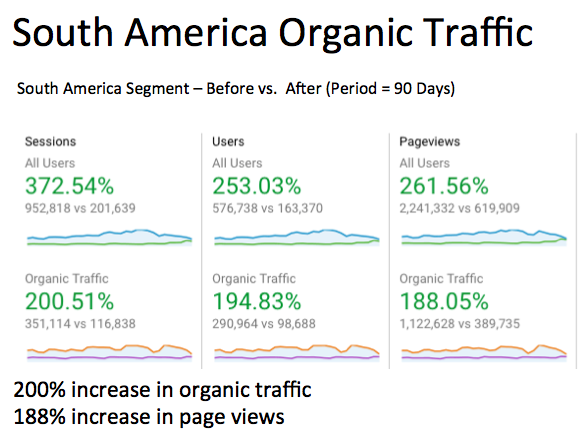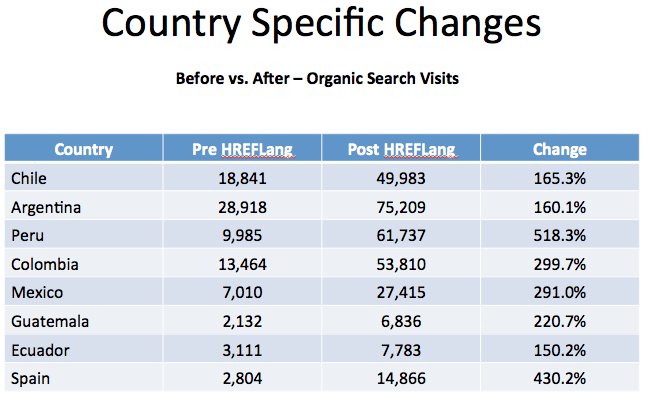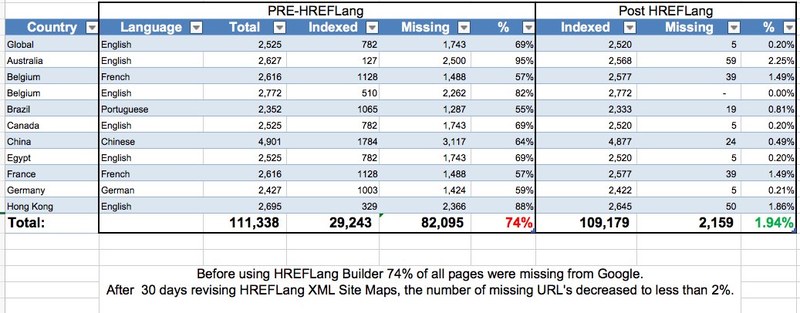HREFLang Builder Wins Best SEO Tool
April 7, 2018Reducing Language Errors in Google Webmaster Tools
May 1, 2018Many companies cut corners trying to cover the 19 countries and territories from Mexico into the Caribbean and down into Central and South America by lumping them into a “Latin America” go-to market strategy. This is done typically with a single regional site or by using copy and paste of an existing Spanish language site into country folders and wait for traffic from this fast-growing region to roll in.
This second option, cloned individual market sites, is where we see the most performance problems. In the majority of the cases, there is no way to distinguish these cloned sites from any another Spanish version of the site. Yes, some of them have added local currencies; different address and phone number and maybe some of the more professional have adjusted for the linguistic differences. The more effort you make the better you will perform not just with SEO but in sales.
Our most recent HREFLang implementation success story did many things correctly. They had 7 different sites for the region plus the standard “LatAm” regional catch-all site and a site dedicated to Spain. They did have unique currencies, contact information in schema tags in the footer, HTML Country and Language Tags in the header, and most of the sites had some level of language localization for the market. They thought all was good which is why they did not know they had a problem.
This belief was further compounded by their Global Search Agency’s use of an enterprise SEO management tool to provide them rank reports. The local market reports showed they were ranking well in these markets especially for branded and product name terms. What the agency did not report was that in most cases, it was the wrong country page that was ranking.
The client first started working with Back Azimuth using DataPrizm to catalog and mine keyword opportunities. As part of the DataPrizm onboarding process, we set Preferred Landing Pages to all of the key product keywords. We had an alert that a different country page is ranking for the key products. We dug deeper and found that in most markets an Argentina page or regional page was ranking vs. the local pages and the following additional challenges.
Fixing Incorrect Country Page Problems
We imported all of the XML site maps into HREFLang Builder and created the HREFLang XML site maps and immediately encountered a few problems:
Problem 1 – 301 Redirects to Regional Pages
We had a number of product pages for products that were not yet sold in the region or no longer sold in the market, so the redirect was correct but you should update the xml site maps to remove these URLs.
Problem 2 – Different Country Canonical Tags
For Peru, the pages were cloned and the dev team left the canonical tag to the old site. For example, the new pages were copies and added to /pe/es but the canonical tag still had a reference to /ar/es so Google was not indexing the pages from Peru. A simple crawl of the site post-launch should have detected this. Also, a simple check of local page index rates would have identified this problem.
Problem 3 – Missing Pages
Similar to problem 2, but not because of a new product or a sunset product, but due to the page not actually being localized. Since it was not localized their CMS did not build a page, but the tool that was building XML site maps was automatically adding a page. By using our “Missing Page” feature we were able to quickly identify which pages had not been added to XML site maps and set them for localization. Note, we do not add an entry in the HREFLang XML unless there is a matching page.
We could spot most of these problems in less than 1 hour with the error detection and “Missing Pages Report” that are native to HREFLang Builder. It took a few hours to clean up the easier issues and reload the HREFLang XML site map. Once uploaded to the server and refreshed in Google Search Console, we started seeing some changes as early as the next day and within a month, the correct country page was ranking for many of the products. We did a recheck 3 months later and the entire region as a whole had a traffic increase of over 200%.
Problem 4 – Agency Resistance
The global Agency, in this case, was another detractor. They were against using XML site maps as they had a proposal to build a feature for their CMS to generate the tags in the page. Note, this company has 72 market sites so adding that much code to the page was crazy. Second, they argued that by altering the pages ranking we would severely impact traffic to Argentina and Spain. Argentina was getting a lot of traffic due to it ranking in many countries but the orders were low due to different country, currency, and shipping costs.
Significant Improvements in Performance

We then broke down the traffic to the individual country sites and that is where we saw even more improvement. Peru, where the canonical was pointing to another country, had an increase in traffic of nearly 600%.

Notes:
Spain traffic did not decline as the agency predicted, in fact, it was the second largest increase with 430% as many of the pages that were ranking were for the regional site.
Argentina traffic also increased by 160% as did revenue as more of the local people entered the site vs. from other markets.
It was not that much effort to make this improvement. Yes, it identified many problems with the site and the workflow but for each problem that was fixed more improvement was realized. No fancy SEO techniques were required, just making sure all the signals were correct. By using XML site maps for the HREFLang management we get a lot of flexibility in tuning them, as well as ensuring that they are correct, maximizing overall indexing and market identification.


